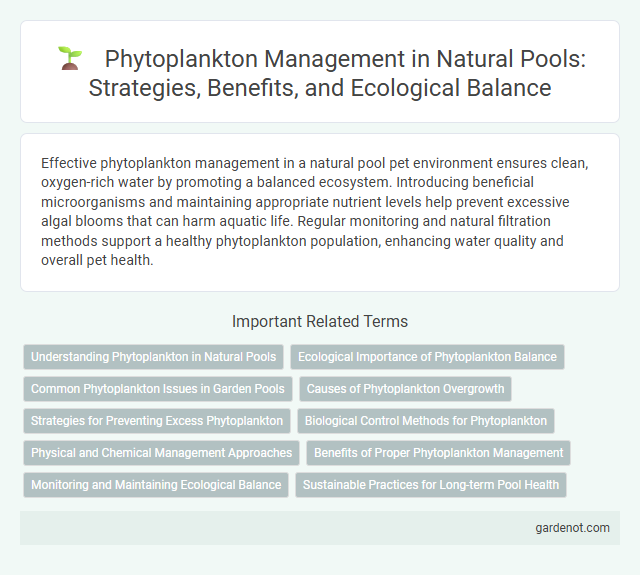Effective phytoplankton management in a natural pool pet environment ensures clean, oxygen-rich water by promoting a balanced ecosystem. Introducing beneficial microorganisms and maintaining appropriate nutrient levels help prevent excessive algal blooms that can harm aquatic life. Regular monitoring and natural filtration methods support a healthy phytoplankton population, enhancing water quality and overall pet health.
Understanding Phytoplankton in Natural Pools
Phytoplankton serve as primary producers in natural pools, playing a crucial role in oxygen production and nutrient cycling. Managing their growth involves balancing light exposure, nutrient levels, and water circulation to prevent algal blooms that can disrupt the ecosystem. Effective phytoplankton management enhances water clarity and promotes a healthy, stable aquatic environment in natural pools.
Ecological Importance of Phytoplankton Balance
Phytoplankton play a crucial role in natural pool ecosystems by maintaining water quality and supporting aquatic food webs. Balanced phytoplankton populations prevent harmful algal blooms that can deplete oxygen and release toxins, ensuring a healthy environment for fish and beneficial microorganisms. Effective phytoplankton management preserves the natural biological equilibrium, enhancing the pool's ecological stability and biodiversity.
Common Phytoplankton Issues in Garden Pools
Common phytoplankton issues in garden natural pools include excessive growth causing green water and reduced clarity, often triggered by high nutrient levels like nitrogen and phosphorus. Managing nutrient input and promoting balanced aquatic plant life are essential to prevent algal blooms and maintain ecosystem health. Regular monitoring and natural filtration methods help control phytoplankton populations and support water quality.
Causes of Phytoplankton Overgrowth
Phytoplankton overgrowth in natural pools occurs primarily due to excess nutrients, such as nitrogen and phosphorus, often introduced from runoff containing fertilizers or organic waste. Warm temperatures and stagnant water conditions further exacerbate the rapid proliferation of phytoplankton. Insufficient water circulation and lack of natural predators also contribute significantly to uncontrolled algal blooms.
Strategies for Preventing Excess Phytoplankton
Effective phytoplankton management in natural pools relies on controlling nutrient inputs such as nitrogen and phosphorus, which prevent excessive algal growth and maintain water clarity. Implementing biological controls like introducing filter-feeding organisms and promoting aquatic plants helps compete with phytoplankton for nutrients and light. Regular monitoring of water quality parameters, including nutrient concentrations and chlorophyll levels, enables timely intervention and sustains a balanced ecosystem.
Biological Control Methods for Phytoplankton
Biological control methods for phytoplankton in natural pools leverage organisms such as zooplankton and specific fish species that feed on phytoplankton, effectively reducing algal blooms without chemical intervention. Introducing filter-feeders like Daphnia or tilapia supports ecological balance by targeting excessive phytoplankton growth, promoting clearer water quality. Maintaining a diverse aquatic ecosystem enhances these biological controls' effectiveness, minimizing the risk of harmful algal proliferation.
Physical and Chemical Management Approaches
Phytoplankton management in natural pools involves physical methods such as sedimentation, filtration, and light control to reduce excessive algal growth and maintain water clarity. Chemical management approaches include the controlled application of algaecides like copper sulfate or hydrogen peroxide, along with nutrient regulation through phosphate binding agents to prevent eutrophication. Combining these strategies helps balance the natural ecosystem while minimizing harmful blooms and promoting a healthy aquatic environment.
Benefits of Proper Phytoplankton Management
Proper phytoplankton management in natural pools enhances water clarity by preventing excessive algal blooms, which ensures a healthier aquatic environment. Maintaining balanced phytoplankton levels supports oxygen production, critical for aquatic life and overall ecosystem stability. Effective control reduces the risk of harmful toxins and improves the aesthetic appeal of the natural pool, promoting safer recreational use.
Monitoring and Maintaining Ecological Balance
Effective phytoplankton management in a natural pool involves regular monitoring of water quality parameters such as nutrient levels, pH, and temperature to prevent harmful algal blooms. Employing biological controls like introducing specific aquatic plants and beneficial microorganisms helps maintain ecological balance by competing for nutrients and suppressing excessive phytoplankton growth. Consistent assessment and adjustment of environmental conditions ensure a stable ecosystem, promoting clear water and supporting diverse aquatic life.
Sustainable Practices for Long-term Pool Health
Effective phytoplankton management in natural pools relies on sustainable practices such as optimizing nutrient levels through controlled organic matter input and promoting native aquatic plants that compete for resources. Maintaining balanced light exposure and regular water circulation reduces excessive algal blooms without relying on chemical treatments. Implementing these ecological strategies supports long-term pool health by preserving water quality and biodiversity.
Phytoplankton management Infographic

 gardenot.com
gardenot.com